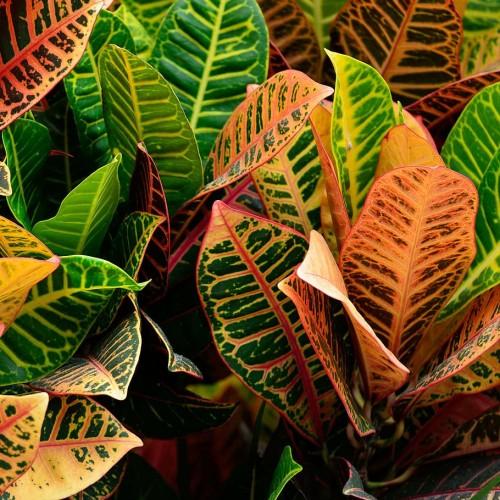
croton
Codiaeum variegatum var. pictum
Cycle:
Perennial
Watering:
Average
Hardiness Zone:
11 - 12
Flowers:
Flowers
Sun:
full sun
Soil:
Well-drained
Fruits:
Fruits Ready In
Edible:
Yes
Leaf:
Yes
Growth Rate:
Low
Maintenance:
Moderate
Salt Tolerant:
Yes
Indoors:
Yes
Care Level:
Moderate
watering
Water your croton deeply once per week, ensuring that the soil is saturated. Do not water again until the top inch or 2 of soil have dried out. In the warmer months, you may need to water more frequently. During the winter, you can reduce the frequency of watering. If you notice the leaves drooping and wilting, you may need to water more frequently.
sunlight
Croton (Codiaeum variegatum var. pictum) requires bright, direct sunlight for most of each day to stay healthy and vibrant. The best sunlight exposure for crotons is 6 to 8 hours of direct sunlight daily, in the early morning and afternoon, with dappled or bright indirect light midday. While the exact amount of sunlight can vary according to the individual plant, croton requires regular exposure to bright sunlight to maintain its colorful foliage, or else this plant will not thrive. In a warm climate, outdoors, provide croton with full morning sun, then dappled or filtered light during the hottest part of the day. In a cool climate, provide full morning sun and, if temperatures consistently exceed 75 degrees Fahrenheit during the hottest part of the day, some late afternoon sun is beneficial.
pruning
Croton should generally be pruned in the spring or early summer when new growth begins. This species is usually pruned severely, with up to 1-half of its older branches cut back to promote a more compact, attractive shape and better foliage display. When pruning, it is important to remove dead and diseased branches at the first sign of problems. Be sure to clean your pruning tools between each cut to prevent the spread of disease. Fertilize lightly after pruning to help the plants to quickly recover. With proper pruning and care, croton can provide attractive foliage and flowers for many years.
Propagation
Season
Hardiness Map
FAQ
How toxic are croton plants to pets?
Croton plants are toxic to pets if ingested. The plant contains toxins that can cause vomiting, excessive drooling, and upset stomach as soon as 15 minutes after ingestion. If ingested, seek medical attention for your pet as soon as possible. Signs of poisoning may be difficult to identify and may require extensive medical treatments. Since these plants are toxic, it is important to keep them away from pets and children in the home.
Can croton plants bloom indoors?
Yes, croton plants can bloom indoors. They like bright, indirect light, so it is important to place them where they can get plenty of sunlight that is not too direct. They also need moist, well-draining soil and should be watered regularly. Additionally, these plants are susceptible to several pests, so it is important to check them periodically and examine any discolored leaves. With the right conditions, croton plants can provide colorful and vibrant blooms indoors.
Are low light conditions suitable for croton plants?
Low light conditions are acceptable for croton plants in moderation. Depending on the type of croton and how much light it needs, it can survive in low light conditions. If a croton plant is in a low light environment, it can reach health and growth, but it will not thrive. The foliage of croton plants will not be as vibrant and colorful when they are in low light conditions, so it’s important to adjust the environment accordingly. Be sure to give your croton plenty of bright, indirect sunlight to help it thrive.
How often should you water croton plants?
Croton plants typically require consistently moist soil, so you should water them when the top 1-2 inches of soil has dried out. Depending on the size of the pot, weather, and other factors, this could mean watering every 2-4 days. Additionally, it can be beneficial to mist the leaves of the plant with water to provide additional humidity, which may need to be done once or twice a week.
